Aaron J. Patton, Assistant Professor, Mike D. Richardson, Professor, and Doug E. Karcher, Associate Professor, Department of Horticulture, University of Arkansas, Fayetteville 72701; John W. Boyd, Professor, Crop, Soil & Environmental Science, University of Arkansas Cooperative Extension Service, Little Rock 72203; Zachary J. Reicher, Professor, Department of Agronomy, Purdue University, West Lafayette, IN 47907; Jack D. Fry, Professor, Department of Horticulture, Forestry, and Recreation Resources, Kansas State University, Manhattan, KS 66506; J. Scott McElroy, Assistant Professor, Department of Agronomy and Soils, Auburn University, Auburn, AL 36849; and Gregg C. Munshaw, Assistant Professor, Mississippi State University, Department of Plant and Soil Sciences, Mississippi State 39762 Corresponding author: Aaron J. Patton. ajpatton@uark.edu
Introduction
Common bermudagrass (Cynodon dactylon L. Pers.) is a warmseason turfgrass species that is grown in the transitional and southern climatic zones of the US. It is suitable for lawns, athletic fields, and golf course tees, fairways, and roughs. Common bermudagrass was first available by seed in the US around 1940, but the first improved cultivar, ‘Arizona Common,’ was released in the 1960s (39). Although bermudagrass has been available by seed for years, its use in high-value turfs has increased in recent years due to the release of new cultivars with turfgrass quality similar to hybrid bermudagrass (C. dactylon × C. transvaalensis Burtt-Davy) (22). Many improved seeded bermudagrass cultivars have better winter hardiness and wear tolerance than Tifway hybrid bermudagrass (22,23,24), which is considered an industry standard. Compared to common bermudagrass, many improved cultivars have better winter hardiness and improved turfgrass quality (22,23,24), and are more sustainable for the transition zone. Many of these new releases are more genetically diverse than previous releases (48), which may help explain why they exhibit improved characteristics compared to Arizona Common. This paper summarizes recent research on establishing bermudagrass by seed in the transition zone and can be used as a guide by practitioners wishing to establish seeded bermudagrass.
Cultivar Selection
Factors to consider when selecting a bermudagrass cultivar include seed availability, budget, maintenance level, pest tolerance, turf quality, and regional adaptation. However, the most important factors for selecting a cultivar for the transition zone are turfgrass quality and winter hardiness. Winter hardiness is an important factor in selecting cultivars since bermudagrass can be severely damaged periodically by severe winters in the transition zone (11). Other factors to consider are genetic color, spring dead spot resistance, establishment vigor, and divot recovery. Rankings of turfgrass quality, winter hardiness, turfgrass color, spring dead spot resistance, establishment vigor, and divot recovery among the seeded cultivars from the 2002 National Turfgrass Evaluation Program bermudagrass trial are provided in Table 1 based upon data collected in transition zone states. Additionally, the mean of these rankings is provided as well as a weighted mean ranking to help managers select cultivars (Table 1). The weighted mean ranking places specific emphasis on winter hardiness and turf quality (40% each) since these factors are especially important for selecting well-adapted, high quality cultivars in the transition zone. Less emphasis is placed on turf color, spring dead spot, establishment vigor and divot recovery rankings (5% each).
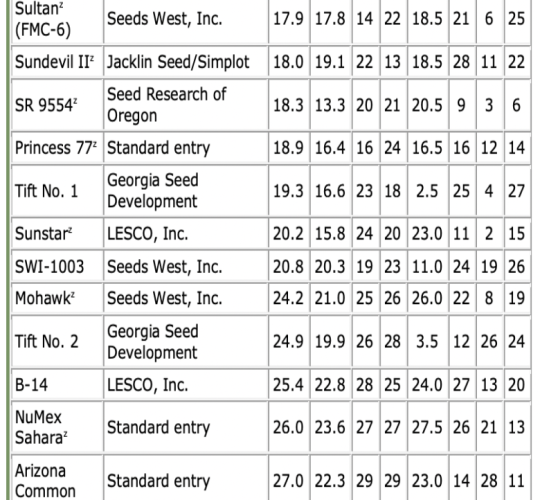
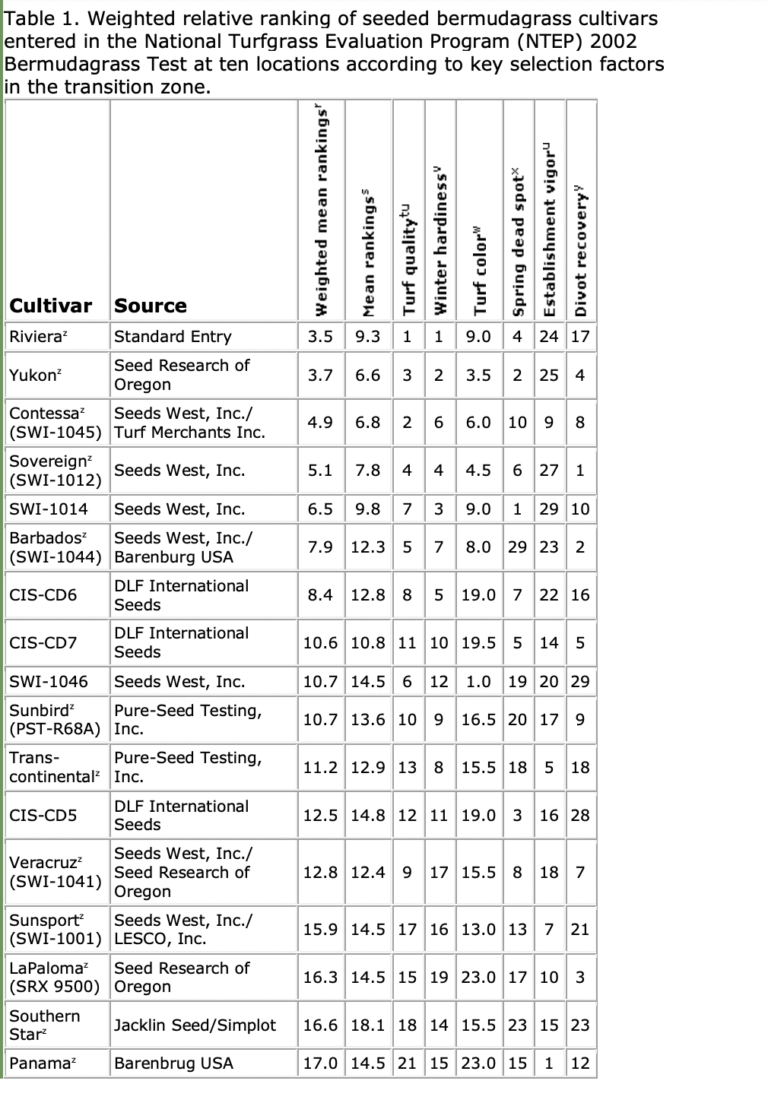
When evaluating both turfgrass quality and winter hardiness, ‘Riviera,’ ‘Yukon,’ ‘Contessa,’ ‘Sovereign,’ ‘Barbados,’ and ‘Sunbird’ were among the commercially available cultivars that rank in the top ten. Additionally, there were two experimental lines that were among the top ten for both turf quality and winter hardiness. By contrast, ‘Arizona Common’ and ‘NuMex Sahara’ ranked among the bottom group of cultivars in turfgrass quality and winter hardiness and were not in the top ten in any of the selection factors examined.
Site Preparation
Three common scenarios for establishing seeded bermudagrass include planting on bare soil where there is no existing crop, conversion from an established cool-season sward, or conversion from an existing sward of bermudagrass. Regardless of establishment scenario, it is important to correct nutrient deficiencies and modify soil pH as well as correct drainage problems prior to establishment. Reports are variable on the optimum soil pH for bermudagrass growth (8,16) with optimum growth occurring between 5.0 and 6.5. It should be noted that where soil pH is < 5.0, differences in aluminum toxicity exist among seeded cultivars (19).
Scenario 1: No existing crop. Before seeding into bare ground, perennial grassy weeds should be controlled with glyphosate (N-(phosphonomethyl)glycine) prior to tilling or by soil fumigation. Seeds should be incorporated into the top 1/8 inch of soil after seeding (39). Bermudagrass establishes most quickly when the soil is tilled prior to seeding and can produce 95% cover by 45 days after planting when there is no weed competition (33).
Scenario 2: Conversion from cool-season turf. There are two approaches to successfully establishing seeded bermudagrass into an existing stand of cool-season turfgrass such as perennial ryegrass (Lolium perenne L.) or tall fescue (Festuca arundinacea Schreb.). The first option is to remove all plant competition prior to seeding by killing the existing turf with glyphosate, followed by aerification and/or verticutting to prepare the seedbed prior to seeding. Using this option, researchers achieved over 87% Yukon bermudagrass coverage prior to winter in Kentucky when seeded at 0.5 lb pure live seed (PLS)/1000 ft² in July or over 93% ‘Mirage’ bermudagrass coverage prior to winter in Indiana when seeded at 1.0 lb PLS/1000 ft² in May (31,45). This is the preferred method for converting athletic fields before the fall football season or golf course turf during a renovation. Although this method is disruptive and would likely require that the area be closed during establishment, it is more effective and speeds establishment compared to strip-seeding.
A second option for converting a cool-season turf to bermudagrass without closing the area is to use a strip-seeding technique (Fig. 1). Fry et al. (12) reported over 55% bermudagrass coverage in a perennial ryegrass sward after one year, and over 86% bermudagrass coverage after two years when 2-inch-wide strips, 15 inches apart, were treated with glyphosate and seeded to Riviera bermudagrass. The main advantage to this technique is that the entire sward is not disrupted, allowing turf areas such as golf courses and athletic fields to remain open and avoid revenue losses. Strip-seeding also requires less seed, lowering establishment costs by approximately $1,600/acre compared to the previous method (12). The main disadvantage to this method is that it could take an additional year to convert a fairway or athletic field from perennial ryegrass to bermudagrass. Glyphosate, atrazine (6-chloro-N-ethylN’-(1-methylethyl)-1,3,5-triazine-2,4-diamine), or simazine (6- chloro-N,N’-diethyl-1,3,5-triazine-2,4-diamine) are recommended in winter to eradicate remaining cool-season turfgrasses from dormant bermudagrass once the bermudagrass coverage exceeds 80% (12). Alternatively, a sulfonylurea herbicide such as foramsulfuron (1-(4,6-dimethoxypyrimidin-2-yl)-3-[2- (dimethylcarbamoyl)-5-formamidophenylsulfonyl]urea) could be used on actively growing bermudagrass to control remaining coolseason grasses (47)
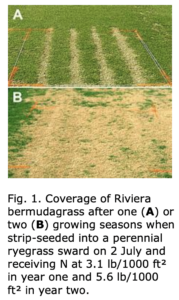
Attempts to establish seeded bermudagrass in existing perennial ryegrass without applying glyphosate prior to seeding have been largely unsuccessful. A maximum of 27% Mirage bermudagrass coverage was obtained after one season in spite of aerification and verticutting prior to seeding at rates as high as 3.0 lb PLS/1000 ft² (31). Additionally, plant growth regulators applied to perennial ryegrass prior to interseeding bermudagrass in Kentucky did not suppress perennial ryegrass enough to allow seedlings to emerge and compete with existing turf (45). As with seeded zoysiagrass (Zoysia japonica Steud.), interseeding directly into perennial ryegrass is unsuccessful likely because of decreased light penetration and soil temperatures at the base of the canopy, reduced seed-to-soil contact, increased plant competition, and allelopathic effects from perennial ryegrass (49,50).
Scenario 3: Conversion from existing bermudagrass. Converting an existing sward of bermudagrass to an improved seeded bermudagrass cultivar is difficult. Fumigation with methylbromide or dazomet (tetrahydro-3,5-dimethyl-2H-1,3,5- thiadiazine-2-thione) is the best option for removing existing bermudagrass prior to seeding (44), but this option may not be available and is expensive. If fumigation is not an option, three applications of glyphosate over the growing season (May, June, and August) will adequately control preexisting bermudagrass (14). Additional research has shown that tank mixing glyphosate with fluazifop-P ((R)-2-[4-[[5-(trifluoromethyl)-2- pyridinyl]oxy]phenoxy] propanoic acid) will improve bermudagrass control over glyphosate alone, but two to three applications are still necessary for adequate control (10,42). Treated areas should be allowed to regrow from stolons and rhizomes before making the sequential applications. Fluazifop-P has residual soil activity, so seeding should be delayed for 30 days after application. This process will require most of the growing season requiring an additional growing season for conversion. To reduce the time needed for conversion, recent work has shown that applications of glyphosate or glyphosate + fluazifop-P two weeks prior to autumn frosts followed by an early spring seeding of an improved bermudagrass cultivar is a successful way to convert an existing common bermudagrass sward (28).
Seeding Date
Researchers in Mississippi reported that seeded bermudagrasses are most susceptible to winter damage during the initial winter after planting (34). Therefore, it is important to seed early in the growing season to enhance winter hardiness. Research with Arizona Common bermudagrass indicated that when seeded in Oklahoma, winter hardiness was less when seeded after 9 May than before (1). Further research on improved cultivars of common bermudagrass confirmed the importance of early seeding dates for improving winter survival (36). April and May seeding dates improved bermudagrass winter survival compared to June and July seeding dates in Arkansas (36). The researchers also found cultivars with excellent winter hardiness, such as Yukon, can be seeded later in the season with reduced risk of winterkill (36).
Early seeding is important for proper establishment, but the question remained whether seeding prior to April could be successful. Recently, Shaver et al. (41) examined differences in establishment of various dormant seeding dates. Dormant seeding refers to any seeding when soil temperatures are below the normal range required for germination and this practice is common with cool-season turf (35). Bermudagrass germination is reported to occur when temperatures reach 68°F, with optimum germination occurring between 77 and 104°F (40). Dormant seeding dates of 15 February and 15 March in Arkansas were successful with germination typically occurring around the middle of April (41). Additionally, plants established faster as a dormant seeding than traditional April and May seeding dates. Shaver et al. (41) found that bermudagrass germination in dormant-seeded plots occurred in the field at soil temperatures (1-inch depth) as low as 59°F, indicating that bermudagrass can germinate at cooler temperatures than previously reported. Seeding in late winter is a viable option for golf course or athletic field schedules as work loads, and use patterns are typically lighter during these months compared to April or May. Dormant seeding in Northern areas of the transition zone where late-spring frosts are common may be more risky since frost could damage bermudagrass seedlings. However, in Shaver’s work on dormant seeding, a late spring freeze (air temperatures < 25°F) occurred after germination in one year of the trial and the seedlings were not significantly injured by this event (M. D. Richardson, unpublished data).
Although recommended, it is not always possible to seed early during the growing season. A growing degree day (GDD) model was applied to the establishment of bermudagrass and used to predict the latest possible summer seeding date at various locations in the transition zone. Using the formula GDD = [(Max. Temp. °C + Min. Temp. °C) / 2] — 5°C, at least 950 accumulated growing degree days prior to 1 October are required to achieve 95% or more Mirage bermudagrass coverage in Indiana and Kentucky (33). Using this GDD model and 30-year normal weather data, bermudagrass could be seeded as late as 2 August in West Lafayette, IN; 6 August in Washington, DC; 6 August in Manhattan, KS; 8 August in Louisville, KY; 8 August in Fayetteville, AR; 9 August in Nashville, TN; and 9 August in St. Louis, MO and still achieve 95% or more coverage prior to winter (Fig. 2). It is important to note that establishment vigor is different among cultivars (23) and Mirage bermudagrass typically establishes more quickly than Riviera and Yukon. Considering differences in establishment vigor, the seeding window for most bermudagrasses is late winter to 1 August throughout the transition zone. It is imperative to seed bermudagrass as early as possible to reduce the risk of winter injury (36). Therefore, our recommendation is to seed no later than 1 June in the transition zone.
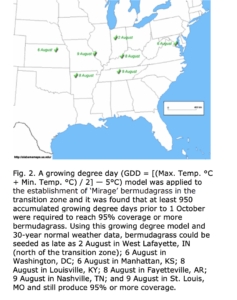
Seeding Rate
Arizona Common bermudagrass has historically been established by seeded 2.0 lb PLS/1000 ft², but recent research favors lower seeding rates. Munshaw et al. (29) found that seeding rates of 0.25 to 0.5 lb PLS/1000 ft² produced plants that had better stolon fitness than those seeded at higher rates. Although low seeding rates may increase stolon fitness, winter survival of seeded bermudagrass has not been measurably affected by seeding rate (29,33). Higher seeding rates can produce higher initial tiller and seedling densities, but Patton et al. (33) found coverage of Mirage bermudagrass seeded in June or July was not enhanced by seeding rates greater than 1.0 lb PLS/1000 ft² as early as 14 days after seeding. Furthermore, turfgrass coverage 42 days after seeding was similar for seeding rates ranging from 0.25 to 3.0 lb PLS/1000 ft². Similarly, it was found that Mirage bermudagrass seeding rates ranging from 0.5 to 1.5 lb PLS/1000 ft² had little impact on establishing bermudagrass in perennial ryegrass treated with glyphosate (31). Based on the aforementioned research, a seeding rate of 0.5 to 1.0 lb PLS/1000 ft² is recommended in most situations.
There are reports of differences in bermudagrass seed size (2), which could influence seeding rate. Seed counts of Riviera bermudagrass for hulled, unhulled, and coated seed were approximately 2,900,000, 1,700,000, and 725,000 seeds/lb, respectively (A. J. Patton, unpublished data) (Fig. 3), indicating that the number of seeds per pound is slightly higher than Arizona Common (2).
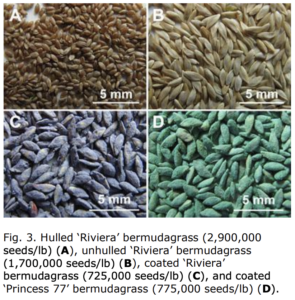
Although the number of seeds per pound differs by cultivar and coating, there is typically no distinction made when recommending a seeding rate. Many improved bermudagrass cultivars, such as Riviera and Yukon, are sold with a seed coating containing fertilizer, fungicide, or other products to improve handling, germination, and establishment (Fig. 3). This coating decreases the number of pure live seeds per pound by dramatically lowering purity, therefore seeding costs increase because higher seeding rates are needed. By definition, pure live seed is determined by multiplying the germination percentage by the percent purity of the seed lot. The weight of seed required to supply 1.0 lb of PLS is about 1.09 lb with uncoated seed and about 2.32 lb of coated seed.
Post-Seeding Weed Control
Weed control is important when seeding bermudagrass in nonfumigated soil because the optimum seeding period coincides with the germination of summer grassy and broadleaf weeds. Grassy and broadleaf weeds compete for resources and reduce seeded bermudagrass establishment if they are not completely controlled before renovation or after seeding. Though weed species and pressure vary among sites, weeds that commonly reduce bermudagrass establishment in the transition zone include crabgrass (Digitaria spp.) (Fig. 4), goosegrass (Eleusine indica L. Gaertn.), and nutsedge (Cyperus spp.).
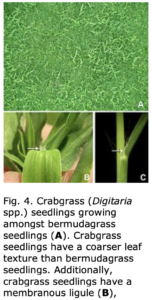
Many herbicides are labeled for weed control in established bermudagrass, but currently only carfentrazone (X,2-dichloro-5-[4- (difluromethyl)-4,5-dihydro-3-methyl-5-oxo-1H-1,2,4-triazol-1-yl]- 4-fluorobenzenepropanic acid) and quinclorac (3,7-dichloro-8- quinolinecarboxylic acid) are labeled for use on bermudagrass seedlings (3,4). Researchers have realized the need for studies evaluating herbicide safety on bermudagrass seedlings and several papers have recently been published on this topic. Herbicide applications are often based on the date emergence occurs or on plant age. Researchers working with weed control in seedling bermudagrass have defined emergence as a uniform stand of oneleaf seedlings about 0.5 inch tall (33), or where 75% of seedlings had emerged (20). Other researchers have timed herbicide applications according to the onset of stolon development (21). Germination typically occurs 7 to 10 days after seeding under optimum conditions (Fig. 5). Emergence occurs once the majority of the stand has germinated and begun to develop. Although emergence typically occurs after germination approximately 14 days after seeding under optimum conditions, emergence can occur later if bermudagrass is dormant seeded, seeded when soil and air temperatures are cool, or when soil moisture is limiting. Research evaluating safety of herbicide applications on various cultivars timed according to bermudagrass seedling emergence or stolon development is summarized in Table 2. Herbicide tolerance may vary among seeded cultivars with Yukon generally being more susceptible to herbicide injury than ‘Jackpot,’ Mirage, ‘Princess 77,’ Riviera, NuMex Sahara, and ‘Savannah’ (15,20,21). Injury or phytotoxicity to bermudagrass varies among herbicides and varies depending upon timing of application after emergence. However, under dense weed populations, the risk of herbicide injury from early applications may be justified by decreased weed competition, allowing increased bermudagrass coverage.
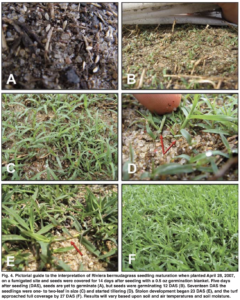
Crabgrass control.
Quinclorac and MSMA (monosodium acid methanearsonate) are safe to use for postemergence control of annual grassy weeds on bermudagrass seedlings as early as 1 week after emergence (WAE) (7,20,33,38). Some minor herbicide injury can be expected with MSMA and quinclorac, but effects are shortlived and herbicide injury from early applications can be justified by decreased weed competition (38) (Figs. 6 and 7). Avoid using quinclorac on Yukon seedlings since they are especially prone to herbicide injury (21). Tank mixes of MSMA with other herbicides can also be used, but some tank mixes with MSMA cause more phytotoxicity than MSMA applied alone (38) (Figs. 6 and 7). Preemergence crabgrass control can be achieved with applications of dithiopyr (S,S-dimethyl 2-(difluoromethyl)-4-(2-methylpropyl)- 6-(trifluoromethyl)-3,5-pyridinedicarbothioate), prodiamine (2,4 dinitro-N3,N3-dipropyl-6-(trifluoromethyl)-1,3-benzenediamine), or pendimethalin (N-(1-ethylpropyl)-3,4-dimethyl-2,6- dinitrobenzenamine) as early as 3 WAE on bermudagrass seedlings (5).
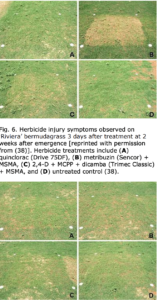
Goosegrass control.
Goosegrass is a difficult weed to control in seedling turf and often requires sequential applications with postemergence herbicides for control. Goosegrass control is best accomplished with postemergence herbicide applications prior to goosegrass tillering. Foramsulfuron and MSMA are the only herbicides labeled for goosegrass control in established bermudagrass, and these are safe to use 1 WAE on bermudagrass seedlings (6,7,20). Preemergence control can be obtained with dithiopyr, prodiamine, or pendimethalin applied as early as 3 WAE on bermudagrass seedlings (5). Oxadiazon (3-[2,4-dichloro-5-(1- methylethoxy)phenyl]-5-(1,1-dimethylethyl)-1,3,4-oxadiazol-2- (3H)-one) is a highly effective preemergence herbicide for goosegrass, but it is yet to be evaluated for safety on bermudagrass seedlings. Diclofop ((±)-2-[4-(2,4- dichlorophenoxy)phenoxy]propanoic acid) works well for postemergence goosegrass control in established bermudagrass, but is phytotoxic to bermudagrass seedlings (20).
Other grassy weed control.
It is often necessary to remove grassy weeds such as annual bluegrass (Poa annua L.) or perennial ryegrass from seedling bermudagrass areas if they are not completely controlled prior to seeding, or if they germinate during grow-in. Foramsulfuron, and rimsulfuron (N-[[(4,6-dimethoxy-2- pyrimidinyl)amino]carbonyl]-3-(ethylsulfonyl)-2- pyridinesulfonamide) control annual bluegrass and perennial ryegrass, and are safe to apply prior to seeding or as early as 1 WAE (5,6,21). Metsulfuron (2-[[[[(4-methoxy-6-methyl-1,3,5-triazin-2- yl)amino]carbonyl] amino]sulfonyl]benzoic acid) and trifloxysulfuron (N-[[(4,6-dimethoxy-2- pyrimidinyl)amino]carbonyl]-3-(2,2,2-trifluoroethoxy)-2- pyridinesulfonamide) can also be used, but should be delayed until 3 or 4 WAE to reduce injury (20,46).
Broadleaf control.
Carfentrazone and quinclorac are both labeled for broadleaf control in bermudagrass seedling turf and can be applied as early as 1 WAE (3,4,7,20 46). Clopyralid (3,6- dichloro-2-pyridinecarboxylic acid), 2,4-D ((2,4- dichlorophenoxy)acetic acid), and dicamba (3,6-dichloro-2- methoxybenzoic acid) are also safe on bermudagrass seedlings 1WAE (20). Other three-way mixtures of herbicides such as 2,4-D + dicamba + mecoprop ((±)-2-(4-chloro-2-methylphenoxy)propanoic acid), and 2,4-D + dicamba + clopyralid can be used on bermudagrass seedlings at the onset of stolon development (21). The combination of clopyralid + triclopyr (((3,5,6-trichloro-2- pyridinyl)oxy)acetic acid) causes more toxicity than other broadleaf herbicides and applications should be delayed until after bermudagrass is established (21,38).
Sedge control.
Of the products labeled for sedge or kyllinga control in established bermudagrass, MSMA and sulfosulfuron (N- [[(4,6-dimethoxy-2-pyrimidinyl)amino]carbonyl]-2- (ethylsulfonyl)imidazo[1,2-a]pyridine-3-sulfonamide) are the safest and can be applied before seeding or as early as 1 WAE (5,20). Halosulfuron (3-chloro-5-[[[[(4,6-dimethoxy-2- pyrimidinyl)amino]carbonyl]amino]sulfonyl]-1-methyl-1Hpyrazole-4-carboxylic acid), sulfentrazone (N-[2,4-dichloro-5-[4- (difluoromethyl)-4,5-dihydro-3-methyl-5-oxo-1H-1,2,4-triazol-1- yl]phenyl]methanesulfonamide), and trifloxysulfuron can be applied 3 WAE or later (5). Trifloxysulfuron + MSMA can also be used on bermudagrass seedlings 2 WAE or later with some shortlived phytotoxicity (38). Imazaquin (2-[4,5-dihydro-4-methyl-4-(1- methylethyl)-5-oxo-1H-imidazol-2-yl]-3-quinolinecarboxylic acid) should not be used on bermudagrass seedlings (5).
Post Seeding Fertilization
Nitrogen fertilization is often applied to increase seedling establishment. Increasing monthly N fertilization from 1.0 to 2.0 lb/1000 ft² using urea did not speed establishment in Kentucky (33). Munshaw et al. (29) found that applying lower N rates (4 lb/1000 ft²/year) using urea during establishment resulted in larger stolons and greater carbohydrate reserves than did higher N rates (12 lb/1000 ft²/year), although they did not observe higher N rates leading to increased winter injury. Additional research found that late-season N applications prior to frost promote fall color retention and do not have a negative effect on bermudagrass winter hardiness (27). Therefore, our current recommendations are to apply 1.0 lb N per 1000 ft² at emergence and again monthly throughout the growing season with the last application being applied no later than 4 weeks prior to the first anticipated frost autumn.
Traffic Tolerance
Compaction is known to reduce the vegetative growth and root development of established bermudagrass (43). Zuk and Fry (50) found that trafficking zoysiagrass after seeding reduces zoysiagrass emergence and coverage by more than 50%. A similar response is likely with bermudagrass seedlings. Therefore, limiting or diverting golf cart and equipment traffic after seeding is strongly advised.
Once fully established, some seeded bermudagrass cultivars exhibit better wear tolerance and divot recovery than hybrid bermudagrass cultivars (18,22). Studies in Indiana on silt loam demonstrate that Riviera is more traffic tolerant than other seeded cultivars such as ‘Mirage’ and Yukon, and the vegetatively established cultivar ‘Quickstand’ (9). These results are similar to findings in Tennessee on silt loam where Riviera had similar traffic tolerance to Tifway, but greater tolerance than ‘Quickstand’ (13). Wear tolerance ratings in Georgia indicate that Riviera is among the group of cultivars with the best wear tolerance, whereas Tifway, Arizona Common, and Princess 77 are less wear tolerant (22).
Costs
Bermudagrass can be established by seed more rapidly and typically at a lower cost than sprigging (30). Seed costs are often around $5/lb for hulled or unhulled bermudagrass seed that has no coating. If seeded at a rate of 1.0 lb PLS/1000 ft², then seed cost per acre is about $242 using non coated seed. Many improved bermudagrass cultivars are available only as coated seed. Coated bermudagrass seed typically costs from $5 to $25/lb, which if seeded at a rate of 1.0 lb PLS/1000 ft², would increase the cost per acre from $519 to $3,094. By comparison, sprigging costs for bermudagrass are about $1,000/acre with sodding costs near $7,500/acre (32).
Herbicide costs during establishment will vary based upon weed pressure, site preparation and seeding technique. A typical herbicide program during establishment might include applications of glyphosate prior to seeding, quinclorac or MSMA as needed to control summer annual grassy weeds, carfentrazone or quinclorac to control summer annual and perennial broadleaves, foramsulfuron or trifloxyfuluron for annual bluegrass and perennial ryegrass control, and sulfosulfuron for sedge control with an estimated cost ranging from $80 to $200/acre. Fertilizer cost is approximately $150/acre to apply 1.0 lb N per 1000 ft² at emergence and again monthly throughout the growing season using urea. If herbicide and fertilizer costs are added to 1.0 lb PLS/1000 ft² seeding costs, then estimated establishment costs excluding labor ranges from $475 to $3,450/acre depending upon seed coating, weed pressure, herbicide selection, and cultivar selection.
Summary
Seeded bermudagrass cultivars with improved turf quality and winter hardiness are commercially available in the transition zone. This paper summarizes a large body of research conducted over the last decade that demonstrates how seeded bermudagrass can be established on golf courses or athletic fields. Establishing seeded bermudagrass will reduce irrigation and pesticide inputs when compared to those needed for cool-season swards in golf course fairways or athletic fields. Additionally, renovating existing swards of bermudagrass with improved bermudagrass cultivars will improve turfgrass quality, and reduce reestablishment costs from winterkill and ultimately increase sustainability.
Summary of procedures for establishing seeded bermudagrass:
1. Apply glyphosate to designated areas to remove existing turf. If bermudagrass is among the existing turf, fumigation or multiple applications of glyphosate or glyphosate + fluazifop will be necessary for control.
2. Correct nutrient deficiencies and soil pH as indicated by a soil test.
3. Lightly till area and correct any drainage problems. If an area cannot be tilled, then core aerify and verticut aggressively to break up soil cores and prepare the seedbed.
4. Seed 0.5 to 1.0 lb PLS/1000 ft² of bermudagrass from February through May. Bermudagrass seeded later than June will be more susceptible to winter injury. Shallow seeding (< 0.125 inch) is recommended for optimum germination.
5. Apply a starter fertilizer at 1.0 to 1.5 lb P2O5/1000 ft² or as soil tests recommend.
6. Maintain a moist seedbed with light, frequent irrigation until plants mature to a point where irrigation frequency can be reduced and amount increased.
7. Apply herbicides for weed control as soon as possible depending upon safety of individual herbicide, weed species and weed pressure (multiple herbicide applications may be necessary).
8. Begin mowing at 0.5 to 0.75 inch or at desired height as soon as needed.
9. Apply 1.0 lb N per 1000 ft² after emergence and again monthly throughout the growing season with the last application being applied no later than 4 weeks prior to the first anticipated frost autumn.
10. Expect 90% bermudagrass coverage in 4 weeks assuming adequate soil temperatures and moisture. Estimated establishment costs excluding labor will range from $475 to $3,450/acre depending upon cultivar selection, seeding rate, seed coating, herbicide choice, and weed pressure.
